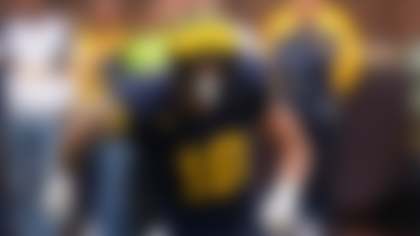It seems predictable that Patriots coach Bill Belichick is going to trade back and trade back even more every draft. In the process of stockpiling selections and economic value, he's also allowed other teams to nab some pretty darn good players with the picks he forfeited.
Last season, Baltimore got Michael Oher and Green Bay took Clay Matthews with the picks the Patriots bailed on to get out of the first round and into the second.
The Patriots moved back twice in the first round this year, surrendering picks that allowed Denver to take Georgia Tech wide receiver Demaryius Thomas and Dallas to draft wide receiver Dez Bryant -- players the Patriots seemingly could have used. New England then selected cornerback Devin McCourty 27th overall, a pick that drew some criticism by the home folks because it didn't fit some needs (McCourty could immediately help special teams and adds depth to a secondary that needs it).
In the second round, New England addressed some of those needs by drafting Arizona tight end Rob Gronkowski then, dipping into the Patriots' new farm system in Gainesville, Fla., took two Florida defenders, end Jermaine Cunningham and inside linebacker Brandon Spikes. Belichick and Gators coach Urban Meyer have a well-documented friendship.
While Gronkowski has some medical concerns -- he missed all of last season following back surgery -- Belichick nabbed three hardcore football players.
The Patriots wouldn't have selected Gronkowski if he was a medical concern. He's a three-down tight end who can block and catch. Spikes' speed won't be an issue because he'll be a two-down, downhill masher who'll be used to stop the Jets' top-rated run offense, the Dolphins' Wildcat and whatever the Bills are doing.
Everyone was wondering what New England was going to do to counter the offseason moves made by AFC East rivals Miami (adding LB Karlos Dansby and WR Brandon Marshall) and New York (trading for CB Antonio Cromartie and WR Santonio Holmes, signing RB LaDainian Tomlinson and LB Jason Taylor, drafting CB Kyle Wilson). We just got somewhat of an answer -- if these players can withstand their red flags. The Patriots could be relying on some young guys to step up quickly, but the types of players New England drafted could have moved them a little closer to keeping pace.
Minnesota's new 1-2 punch
Minnesota's trade on Day 1 of the draft with division foe Detroit allowed the Lions to select game-breaking running back Jahvid Best. The Cal product might end up helping the rebuilding the Lions in the long run. In the short term, though, the Vikings loaded up on physical players to aid them in their immediate push for a Super Bowl.
Pick-by-pick analysis
Bucky Brooks breaks down every selection from the draft, including what he thinks about Bill Belichick and the Patriots continuing to be aggressive with trades. **More ...**
Virginia cornerback Chris Cook, who they took with their first pick (34th overall), is a big corner who fits the Cover-2 scheme. He's limited in coverage and they're going to have to protect him, but he gives them some muscle in run support. He's also insurance in case Cedric Griffin struggles rebounding from the ACL injury he suffered in the NFC Championship Game against New Orleans.
The pick that people are going to be talking about most, though, came with the 19th choice in the second round: Stanford running back Toby Gerhart, the NCAA's leading rusher last season. Gerhart is a big, physical back who's got some giddy-up once he gets to the second level.
He's a different type of option than Chester Taylor, whose free-agent departure to Chicago put Minnesota in the market for a running back.
Gerhart doesn't have the slippery shake of Taylor, but he's far more punishing. With Gerhart throwing haymakers after Adrian Peterson has defenders banged up and gasping, the Vikings added a potentially punishing tandem that could bode well as the season goes along. Gerhart also could allow the Vikings not to veer too far off what they like to do offensively, should Peterson get hurt or continue his 2009 habit of fumbling.
The Vikings spent much of the offseason looking for a bigger, physical backup to Peterson as they did due diligence on running backs like Jonathan Dwyer, Montario Hardesty and Ben Tate -- all backs who can carry heavy loads. Albert Young and Ian Johnson will battle for the No. 3 job, but they might not get much opportunity for touches with Gerhart added to the mix.
Vikings running backs coach Eric Bieniemy is familiar with Gerhart's work after helping try to recruit the back when Bieniemy was an assistant at UCLA. However, Bieniemy left for Minnesota before Gerhart made a decision.
"Two days before signing day, he leaves to go to the Vikings, and that was a major factor in why I didn't go to UCLA.
"Now it's kind of ironic that four years later, I get a chance to finally work with him. I'm excited. I talked to him on the phone briefly and he's excited, and I'm really looking forward to it."
Health matters
We're finding out that it wasn't necessarily character issues that scared teams off Oklahoma State WR Dez Bryant. Some squads were concerned that medical tests showed he had an irregular heartbeat but Dallas, which traded up to No. 24 to take the wide receiver, clearly isn't worried. We also learned that Texas outside linebacker/defensive end Sergio Kindle had some medical issues with his knee that caused him to slip to the 43rd overall slot, where the Ravens took him.
Medical issues occasionally prompt players to slip, but if a team does thorough research and doesn't think the problem is a long-term concern then it won't be scared off. Look at the top overall pick, quarterback Sam Bradford, who missed most of last season with a shoulder injury. His medical records were examined multiple times, and the Rams gambled that he will hold up for a long time.
However, when it comes to issues involving concussions (Detroit's Best, for instance) or heart or other organ issues, teams tend to be more reluctant to make any type of commitment -- especially financially with a high draft pick.
At the NFL Scouting Combine in February, I spoke with a doctor involved with player exams. He told me that every year he will see information that will show existing conditions or the potential for damage that is shared with all teams. How those organizations decide to apply those findings and weigh them against the potential contribution of the player varies. Each year, though, players and teams find out information that ends up costing players a lot of money.
Some observations through three rounds
» The Oakland Raiders might be getting serious about building their roster. The selections of linebacker Rolando McClain (first round), defensive tackle Lamarr Houston (second round) and tackle Jared Veldheer (third round) showed some restraint by a team that typically can't stay away from skilled players or combine stars.
» Tampa Bay's second-round selection of defensive tackle Brian Price was an unexpected, but strong choice, even though it took Oklahoma defensive tackle Gerald McCoy with the third overall pick. Price and McCoy are versatile enough to flex to ends should the Bucs use some 3-4 principles on occasion, even though they are a 4-3 front. Price and McCoy also can play alongside each other and give the Bucs some serious interior punch.
» The 49ers' selection of safety Taylor Mays in the second round -- he was the fifth safety chosen -- capped a nice collection of physical players with their first three picks. San Francisco took offensive linemen Anthony Davis and Mike Iupati in the first round, giving it some muscle up front. Mays is going to have a major chip on his shoulder because he thought he'd be a first-rounder, but he slipped because he's not a prototype modern-day safety.
Teams also could have stayed away because his former college coach at USC, Seattle's Pete Carroll, drafted Texas safety Earl Thomas instead of Mays.
The 49ers are going to have to scheme to fit to Mays' skill set, but his athleticism at 6-foot-3, 230 pounds is so impressive and unique that if they can fit him into their system, the 49ers could further take on the physical, no-nonsense identity of coach Mike Singletary.
» How good must the Cardinals feel? There might not have been another team to have two excellent need players unexpectedly fall to them. Nose tackle Dan Williams, a projected top-20 pick, dropped to them at No. 26. Though it took moving up a few spots in a trade with New England, TCU outside linebacker Daryl Washington was available when they drafted him with the 15th pick in the second round.
» Isn't it amazing that the least talked about quarterback is the one taken first overall?
» The team that everyone needs to pay attention to in every draft: Baltimore. The Ravens traded out of the first round and made a second-round haul of OLB/DE Sergio Kindle and NT Terrence Cody, while getting Ed Dickson, a pass-catching tight end from Oregon, in the third round.
» Buffalo's selection of NT Torell Troup with the ninth pick of the second round wasn't as shocking as it might seem. Troup gained a lot of momentum heading into the draft and could turn out to be a perfect space eater for the 3-4 front the Bills want to employ.
» Chiefs GM Scott Pioli loves the SEC. Kansas City's top three picks were safety Eric Berry (Tennessee), RB Dexter McCluster (Mississippi) and CB Javier Arenas (Alabama). A note on Arenas: After the combine, a scout said that Arenas was so impressive and brilliant in regards to his knowledge of the game analysis, he felt like his interview with him was like dealing with Russell Crowe's character in the movie "A Beautiful Mind."



